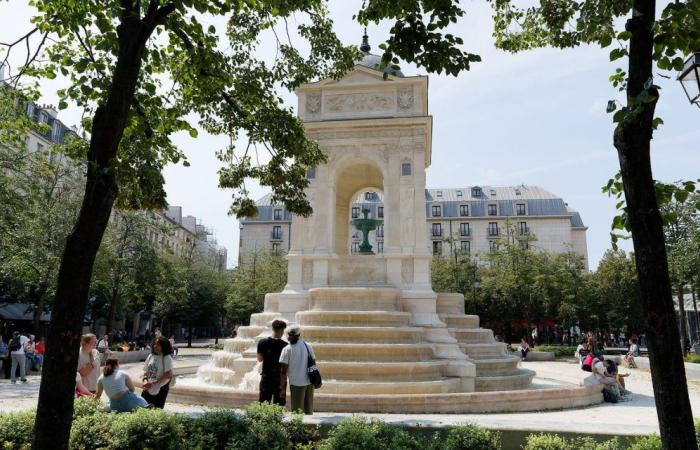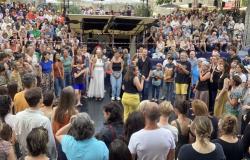Thousands of corpses were once piled up on its site.
And yes! It was on the Place Joachim-du-Bellay (Paris Centre) that the church and cemetery of the Saint-Innocents stood in the Middle Ages. This gigantic necropolis, burial place of about twenty Parisian parishes, the Hôtel-Dieu and several prisons, was open to all winds… This cemetery, although unsanitary, was a popular place for Parisians to stroll – people sometimes even danced on the square! According to the historian Jules Michelet, “haunted by the night of thieves, by the night of the crazy girls who plied their trade on the tombs”.
Over the centuries, the cemetery overflowed to the point that the deceased were buried even in the cellars of the houses in the neighborhood, where fragments of skeletons are still sometimes found today. It was only in 1786 that the bones were transferred to the old quarries in the south of the capital, which became the catacombs of Paris.
She celebrated the entry of Henry II into Paris in 1549
King of France from 1547, Henry II made his solemn entry into Paris alongside his wife Catherine de Medici on June 16, 1549. For the event, the streets were lined with silk fabrics and animated by choirs, pantomimes, tableaux vivants, and jousts were even organized.
The sculptor Jean Goujon is responsible for designing and creating numerous ephemeral architectural elements along rue Saint-Denis (Paris Center) – of which only rare engravings remain. Imagine: in front of the Church of the Holy Sepulcher (now disappeared) sat an obelisk surmounting a rhinoceros, which symbolized France victorious over monsters!
On this route, only one masterpiece by Jean Goujon remains: the Fontaine des Innocents. One of the oldest fountains in Paris. Its decoration includes coats of arms of Henri II and the City of Paris.
This is the first fountain with an architectural dimension, abandoning the traditional layout of the small aedicule in the center of a crossroads. The fountain was then presented as a masonry building, in the form of a loggia opening through two arcades onto rue aux Fers and through a single one onto rue Saint-Denis. This loggia was raised on a fairly high base which hid the fountain’s reservoir. The loggia was initially intended to accommodate a few privileged spectators on the route of the royal procession.
This Renaissance treasure was recognized as a historic monument in 1862.
She narrowly escaped destruction… twice
November 9, 1785: a decree from the King’s Council decides to allocate the location of the cemetery of the Innocents to the herb and vegetable market. The public authorities therefore decided to eliminate the cemetery, but also the parish of Saints-Innocents…
The Fountain of the Innocents, for its part, was narrowly saved from demolition. It is then dismantled and then completely reassembled in the center of the new herb market. Rectangular in plan with two facades, it was transformed into a square building with four facades. The work was entrusted to Bernard Poyet, city architect, particularly sensitive to the taste for classicism and the Renaissance. He called on the sculptor Augustin Pajou to create the missing sculpted decorations, in the style of Jean Goujon, who had sculpted the original nymphs of the first two facades. The new square fountain, topped with a small dome covered in slate, is established on a massive base and is placed parallel to the buildings on rue de la Ferronnerie.
Nearly two hundred years later, as Paris was preparing to build the Forum des Halles (Paris Centre), the idea of dismantling the fountain was once again considered. In February 1973, the High Commission for Historical Monuments decided to keep it on site of the building, particularly because of its fragility.
The Innocents’ Fountain was therefore ultimately kept in place and protected behind palisades for the duration of the work on the “Trou des Halles”. A complex technical device based on reinforced concrete was even designed to anchor it in the ground.
The water will flow there again!
The water from the fountain was originally only distributed in the form of thin streams coming out of six small lion mouths. It came from sources north of Paris captured in Belleville and Pré-Saint-Gervais, then from the Seine thanks to the Notre-Dame pump. Then water arrived in abundance after 1809, coming from the Ourcq canal. To celebrate this event, a big party was organized on August 15, 1809, in the presence of Emperor Napoleon I.is.
Fifty years later, when the Baltard market halls (Paris Centre) were built, the fountain was dismantled again, moved a few dozen metres and reassembled in a new, typically Haussmannian tree-filled square created by the architect Gabriel Davioud: its base was redesigned to enhance the waterfalls, and the Fontaine des Innocents became purely ornamental.
But since 2017, water has stopped flowing at all. Quite the height of irony for an architectural element whose style inspired Sir William Wallace to design his famous fountains!
Also, the work that has just been completed does not only have the objective of restoring the building: the fountain’s hydraulic system will be functional again for the summer! This will constitute a new island of freshness in the Halles district.
Her graceful nymphs are on display at the Carnavalet museum until August 25, 2024.
It is sometimes nicknamed “the fountain of the Nymphs” because of its mythological creatures. Indeed, each facade of the Fountain of the Innocents includes a triangular pediment surmounting an attic provided with a bas-relief paying homage to the marine world: little laughing genies move among the shells and dolphins.
Eight very beautiful naiads occupy the intercolumns. The rendering of the drapes of their clothes, the grace and their elegance, everything about them is remarkable. As part of the restoration, the three nymphs created by Augustin Pajou in the 18the century were restored on site and the five nymphs of Jean Goujon dating from the 16the century were moved to the workshop.
Learn more
Are you fascinated by Parisian heritage?
Subscribe to the Paris.fr newsletter
Default Confirmation Text
Settings Text Html






